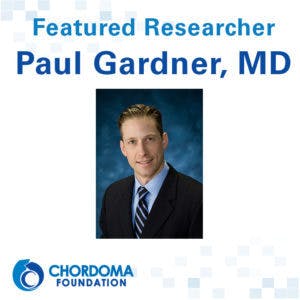
Dr. Paul Gardner’s goal is to put himself out of business.
The neurosurgeon, who directs the Center for Skull Base Surgery at the University of Pittsburgh Medical Center (UPMC), longs for the day when surgery, now standard practice for chordoma tumors at the base of the skull, is no longer the primary treatment. Soon, he hopes, doctors will be able to evaluate each patient’s tumor genetically and customize a treatment plan in which surgery is just one option.
Dr. Gardner believes the Chordoma Foundation will help us get there. But until then, he and his colleagues at the UPMC are developing innovative surgical approaches that improve outcomes for patients with skull base tumors like chordoma. Dr. Gardner specializes in endoscopic endonasal skull base surgery, a technique developed at UPMC where the surgeon inserts specially designed instruments through the nostrils, nasal passages, and sinuses to access the base of the skull. By using a long rod with a tiny lens attached, the surgeon can see the tumor in fine detail on a screen in the operating room to complete this delicate procedure.
“Going through the nose and sinuses is a great way to get to the base of the skull without having to make large incisions in the face or do a big craniotomy,” he explains. “We are also using similar techniques through the eyebrow or crow’s feet, depending on the tumor’s location and the safest way to get to it without disturbing nearby nerves or arteries.”
Dr. Gardner has been involved with the Chordoma Foundation since its inception, and has been amazed by what the organization has accomplished in such a short time. “Just a decade ago, very little was known about this rare form of cancer. Since then, the Foundation has grown into a scientific and patient support powerhouse. I’ve never before seen this kind of progress brought about by an organization. Seeing this commitment has given me both an intellectual desire and a very personal desire to be a part of it.”
Dr. Gardner has been a regular speaker at the Chordoma Foundation’s Community Conferences, and recently joined the Medical Advisory Board to help guide development of the Foundation’s patient services and clinical research strategies. In November 2015, he participated in an international meeting of medical experts organized by the Foundation to define a standard of care for treating chordoma patients at every stage of their disease so that physicians everywhere will know the best course of treatment. He also encourages his patients to donate a portion of their removed tumors to the Chordoma Foundation Biobank so it can be shared with researchers worldwide to better understand and treat chordoma. Other portions of the tumor are used to conduct studies at UPMC, including research to identify biomarkers that can help predict patient outcomes and enable more personalized treatment approaches.
“There are many groups working to solve this problem and coming at it from different angles,” he notes. “The beauty of the Chordoma Foundation is that it brings us all together so we learn from each other, connect the dots, and develop better treatments.”
As soon as that happens, Paul Gardner will happily go out of business.